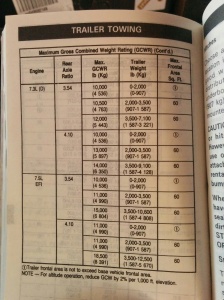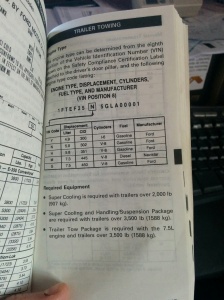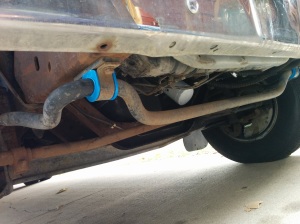And we’re back. I haven’t actually weighed the thing yet but I finally figured out the stupid owners manual and things aren’t as bad as I thought. Basically the 1989 Ford Econoline owners manual was really unclear. What do you think this page means:
I’ll give you a hint, we have the 7.5L engine and the 3.54 Rear Axle Ratio (confirmed with the VIN). I was reading that page as, “There are 3 different versions of the chassis that shipped with that engine and axle combination, one with a GCWR of 10k, one at 11k and one at 15k.” Since I know the trailer hitch we have is rated to 3500 pounds and I know that there are 3 different lengths of chassis that shipped (138″ 158″ and 176″) this seemed like a reasonable explanation. I was assuming that we had the middle chassis that was rated to 11,000 pounds. But that isn’t what that table means at all.
A half a chapter away, I found this page:
Note the “Required Equipment” at the bottom. So if we combine this page with the first, what the first page is saying is that “without any modifications, the GCWR is 10k (which is oddly less than the GVWR); with Super Cooling, the GCWR goes up to 11k; and with Super Cooling and the Handling/Suspension Package, the GCWR is 15k (but if your trailer is more than 3500, make sure you get the Trailer Tow Package too which is just an upgraded hitch).” If only the first page had a note on the second and third rows that said: see page 145 for required equipment, this all would have been much simpler.
At 15,000 pounds, we can absolutely tow the car. Even if you subtract off 20% due to altitude, we’ll still probably be fine but we need to get an accurate weight for the Motorhome to be 100% sure.
As for those extras we’ll need to get to the 15,000 GCWR, I can’t find anything in any of the manuals I have to say that our rig was shipped with those systems, but even so, adding them isn’t that hard. I won’t be able to get the stock parts anymore since it is from 1989, but after market systems that do the same thing or better are easy to find. Aftermarket Transmission Coolers (i.e. the Super Cooling) are $55 on Amazon and I could probably install one in a full day or pay a mechanic 3 hours of labor to do it.
The Handling/Suspension Package is a little harder because I don’t know exactly what the stock one did. My best guess is it definitely included front and rear anti-sway bars (keeps the rig from rocking side to side) after that, though it could be anything. Probably improved shocks, maybe beefier springs, maybe lifted an inch, maybe airbag suspension, I don’t know. It already has an aftermarket front anti-sway bar:
And a rear one I can install myself in a couple hours will only cost about $275 on Amazon. The rest of the stuff though starts to get into things on a car I wont touch because suspension springs kill people and I try to follow the rule of, if I haven’t been trained how to do something, don’t tinker with things that can kill me or blow up explosively (so I probably won’t be doing my own propane work on the RV either). I could probably borrow a spring clamp from an auto parts store, but I still get nervous about it. So basically I need to find out exactly what the stock “Handling and Suspension Package” did and then see what I can find to re-create it. If I can do all the parts (including installation) for less than $1000 I’ll be a very happy camper.
At least we now know that we’re going to keep this rig and can go back to doing other improvements like the roof vents and electrical system. And I promise Allison is helping out too, she’s just finishing up grad school this month and is really busy. She’ll be posting something soon about some decor choices we’ll be making inside.



It’s so surreal to read about these crazy weights involving campervans. A normal van (and consequently van based campers) in Europe can weigh a max of 3500kg (just over 7700lbs). That’s almost entirely due to weight restrictions on driving licenses. If you want to drive anything over 3.5 tons (even the same uprated van) you need a truck license and hardly anyone wants to go down that road. So when you’re saying your base weight is nearly 5 tons (11000lbs) and getting almost up to 7 tons (15000lbs) I have to wonder what is it that you’re carrying?! Even more puzzling is a direct comparison of something like a Winnebago Travato with GVWR of 4250kg and my own campervan based on the same vehicle (Dodge ProMaster = FIAT Ducato) that weighs 3400kg fully loaded with everything you can think of, kayak and solar panels included.
LikeLike
So the weight of the RV itself is 11k pounds. The 15k is adding on towing a car behind it. That said I totally understand the license requirements limiting what people can drive. It’s a lot of vehicle and a lot of people driving rigs this big shouldn’t be!
I think a closer comparison rig-wise would be a cargo box van than a Travato as the Travato I think is just a class B, right? As for weight, a box van has a dry weight of around 6300 pounds (thank you 7.5 liter cast iron big block engine and a crazy steel frame). Add in 300 pounds of fuel, 300 pounds of water, 200 pounds of tanks and water heater, 400 pounds of batteries, and 100 pounds of propane, 150 pounds of solar panels and electrical equipment, 100 pounds of refrigerator, 200 pounds for furnace, oven and microwave, and then 400 pounds of people and dogs puts us over that 3500kg (7700lbs) mark. Still a little surprising that there is another 3000 pounds of personal items, food, tools, furniture, insulation, bikes and towing equipment but there is apparently. Do I wish it were less? Absolutely, but it is what it is.
LikeLike
I thought a closer look would be interesting. Forgive the lenght 🙂
Travato is a class B in US but it is the same as what the Brits call a PVC (panel van conversion), campingbus if you prefer German or just simply van. Vast majority of them are conversions from FIAT Ducato/Citroen Jumper/Peugeot Boxer vans (nearly identical vehicle otherwise known as X250 or X290 after facelift) which are also sold as Dodge Promaster in the US (albeit with a larger engine). There are a handful of other choices for base vehicles from Ford, Renault, Iveco, VW and Mercedes but to keep this a direct comparison I will stick with the X250 as it is what I have and know. There are countless examples by all the major and minor MH manufacturers (Adria, Pössl, Chausson, Hymer etc.) either in class B or class C.
The most obvious weight difference is probably the engine. European X250 comes with a 2.2 (most common), 2.3 or 3.0l diesel while Promaster is either a 3.6 petrol V6 or 3.0l diesel (not the same as European variant).
Propane is usually either in a single tank (~50lbs) or a twin (I have a single), Travato specs say 6gal which I calculated to be about the same as our single.
I have an 80l fresh water tank which is the same as Travato (21-25gal) and a 90l waste water tank which is actually nearly double compared to Travato (11-15gal). Fuel tank is identical at 90l.
Travato has double the battery capacity (100 vs 200Ah) and a gas generator. Heating system, awning (heavy piece of kit), roof rack, bike rack, A/C, solar panel, fridge etc. aren’t that much different than mine. Yet I can’t see how I could possibly load mine beyond 3500kg (let alone 4250 of the Travato GVWR) with two bikes, kayak and all the regular gear plus two persons on board.
That’s why all this makes no sense to me. What is it about the US vans that makes them so heavy? Are they using hardwood furniture, marble countertops and cast iron bathtub?!
LikeLike
No worries about comment length, it’s nice to have a real conversation. I bet some of the difference is just straight up size. We’re 26 ft long which is significantly longer than many of those ones you listed and then we’re a full 8 ft wide (and then mirrors are wider than that) which is wider than would fit on many European streets. Some of those you listed look pretty sweet though, really nice layouts.
LikeLike
Extreme sizes are less common however the differences are far smaller than you might think.
So, X250/90 comes in 3 lenghts between 5.4 (18ft) and 6.4m (21ft) and is 2.05m/6.7ft wide (mirrors not included) as a PVC (class b). The middle lenght (6m) is probably the most common as it also coincides with many ferry/bridge toll price classes (often double above 6m).
MB Sprinter, VW Crafter and Iveco Daily vans can be longer (I guess up to 24.3ft/7.4m).
In class C equivalents (teilintegrierte & alkoven in German) lenghts of over 7m are nothing unusual and they are usually also wider than PVCs by about a foot (2.1-2.4m body + mirrors).
As far as road/street widths go I rarely find them an issue. Places where you couldn’t drive through are usually off limits for all traffic anyway. I rarely need to turn around. If delivery vans, dump trucks and (mini)buses can fit then I can fit as well. That said, a few weeks ago my wife did knock off a mirror hitting another van and had to make a two point turn on a switchback coming down Stelvio pass (google that one). Both were a result of unfortunate coincidence (people taking photos where they shouldn’t).
Btw, you might enjoy looking at promobil.de Among other things there is a directory of all major european MH brands.
LikeLike